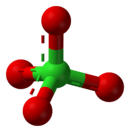Nitronium perchlorate
Nitronium perchlorate, NO2ClO4, also known as nitryl perchlorate and nitroxyl perchlorate, is an inorganic chemical, the salt of the perchlorate anion and the nitronium cation. It forms colorless monoclinic crystals. It is hygroscopic, and is a strong oxidizing and nitrating agent. It may become hypergolic in contact with organic materials.
| |||
| Names | |||
|---|---|---|---|
| Other names
nitronium perchlorate, nitroxyl perchlorate, nitryl perchlorate | |||
| Identifiers | |||
3D model (JSmol) |
|||
PubChem CID |
|||
| |||
| |||
| Properties | |||
| NO6Cl | |||
| Molar mass | 161.45 | ||
| Melting point | 135 °C (275 °F; 408 K) (decomposition) | ||
| Boiling point | decomposition | ||
| decomposes | |||
| Hazards | |||
| Main hazards | Explosive, Oxidizing Agent | ||
| Safety data sheet | [] | ||
| Related compounds | |||
Other anions |
Nitronium tetrafluoroborate | ||
Other cations |
Ammonium perchlorate Nitrosyl perchlorate Sodium perchlorate Potassium perchlorate | ||
Related compounds |
Nitryl chloride | ||
Except where otherwise noted, data are given for materials in their standard state (at 25 °C [77 °F], 100 kPa). | |||
| Infobox references | |||
Nitronium perchlorate was investigated as an oxidizer in solid rocket propellants. Thomas N. Scortia filed for patent on such propellant in 1963.[1] However its reactivity and incompatibility with many materials hindered such use. Coating of nitronium perchlorate particles with ammonium nitrate, prepared in situ by passing of dry ammonia gas over the particles, was investigated and a patent was awarded.[2]
Decomposition rate of nitronium perchlorate can be altered by doping with multivalent cations.[3]
Nitronium perchlorate and ammonium perchlorate do not produce smoke when stoicheometrically burned with non-metallic fuels. Potassium perchlorate and other metal perchlorates generate smoke as the metal chlorides are solid materials creating aerosols of their particles. Of all perchlorates, nitronium perchlorate is the most powerful oxidizer. It can be easily detonated, however.[4]
References
- Thomas N. Scortia. NITRONIUM PERCHLORATE PROPELLANT COMPOSITION, USPTO patent number 3575744, filed Mar 27, 1963; issued Apr 20, 1971; assignee: United Aircraft 5 Corporation.
- Diebold, James P. (17 April 1973). Encapsulation of Nitronium Perchlorate Employing Ammonia to Form Ammonium Perchlorate. (Patent) Department of the Navy, Washington DC. Accession Number: AD0164909.
- NITRANIUM PERCHLORATE REACTION RATE ALTERATION. USPTO patent number 3770527.
- Thiokol Propulsion: Rockets Basics - A Guide to Solid Propellant Rocketry. Checked 2009-06-18. Dead link 15 April 2018.
| HClO4 | He | ||||||||||||||||
| LiClO4 | Be(ClO4)2 | B(ClO 4)− 4 B(ClO4)3 |
ROClO3 | N(ClO4)3 NH4ClO4 NOClO4 |
O | FClO4 | Ne | ||||||||||
| NaClO4 | Mg(ClO4)2 | Al(ClO4)3 | Si | P | S | ClO− 4 ClOClO3 Cl2O7 |
Ar | ||||||||||
| KClO4 | Ca(ClO4)2 | Sc(ClO4)3 | Ti(ClO4)4 | VO(ClO4)3 VO2(ClO4) |
Cr(ClO4)3 | Mn(ClO4)2 | Fe(ClO4)3 | Co(ClO4)2, Co(ClO4)3 |
Ni(ClO4)2 | Cu(ClO4)2 | Zn(ClO4)2 | Ga(ClO4)3 | Ge | As | Se | Br | Kr |
| RbClO4 | Sr(ClO4)2 | Y(ClO4)3 | Zr(ClO4)4 | Nb(ClO4)5 | Mo | Tc | Ru | Rh(ClO4)3 | Pd(ClO4)2 | AgClO4 | Cd(ClO4)2 | In(ClO4)3 | Sn(ClO4)4 | Sb | TeO(ClO4)2 | I | Xe |
| CsClO4 | Ba(ClO4)2 | Hf(ClO4)4 | Ta(ClO4)5 | W | Re | Os | Ir | Pt | Au | Hg2(ClO4)2, Hg(ClO4)2 |
Tl(ClO4), Tl(ClO4)3 |
Pb(ClO4)2 | Bi(ClO4)3 | Po | At | Rn | |
| FrClO4 | Ra | Rf | Db | Sg | Bh | Hs | Mt | Ds | Rg | Cn | Nh | Fl | Mc | Lv | Ts | Og | |
| ↓ | |||||||||||||||||
| La | Ce(ClO4)x | Pr | Nd | Pm | Sm(ClO4)3 | Eu(ClO4)3 | Gd(ClO4)3 | Tb(ClO4)3 | Dy(ClO4)3 | Ho(ClO4)3 | Er(ClO4)3 | Tm(ClO4)3 | Yb(ClO4)3 | Lu(ClO4)3 | |||
| Ac | Th(ClO4)4 | Pa | UO2(ClO4)2 | Np | Pu | Am | Cm | Bk | Cf | Es | Fm | Md | No | Lr | |||

